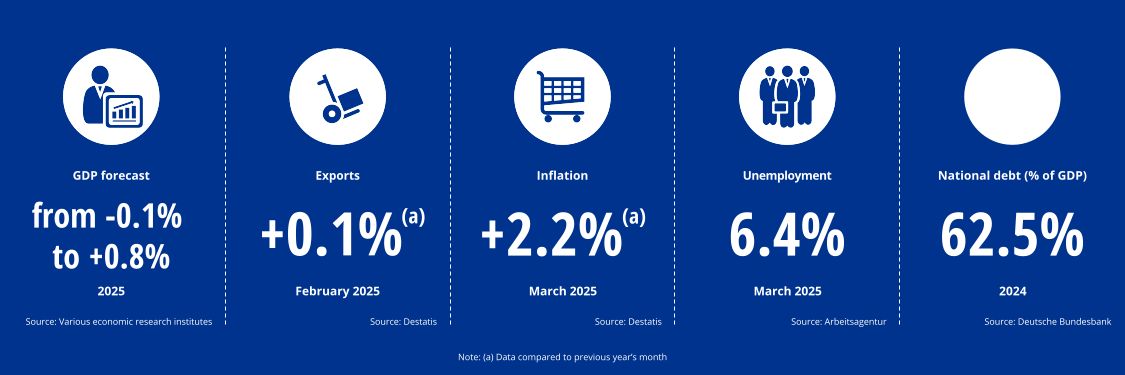With a gross domestic product of 4,305 billion euros in 2024, Germany is the third largest economy in the world after the United States and China and just ahead of Japan, making it the largest economy in Europe. In particular, exports of motor vehicles and vehicle parts as well as chemical products have made Germany the third largest export nation in the world to date. At 70%, the service sector accounts for the largest share of the country's gross domestic product (GDP).
In addition, Germany is a top destination for investors, attracting an ever increasing number of companies to make greenfield investment there. As the largest economy in Europe, Germany entices its investors with its central-european location, but simultaneously puts them off with the current deterioration of Germany's situation as an economic destination.

Data retrieved: 8 April 2025

No recovery of the German economy in sight for 2025 either
The German economy is stuck. Industry in particular is suffering from weak demand and increasing international competitive pressure. At the same time, political uncertainties in Germany and the USA are creating considerable risks. According to the ifo Institute's forecast, the price-adjusted gross domestic product is therefore only expected to increase slightly by 0.2% this year compared to the previous year. This means that the growth forecast has been lowered by 0.2 percentage points compared to the Winter 2024 economic forecast for the current year. Growth of 0.8% is expected for the coming year, thus maintaining the winter 2024 forecast. However, against the backdrop of the upcoming economic policy decisions in Germany and the United States, the forecast risks are high
Business associations are now hoping that the new German government will address the economic problems promptly with appropriate measures and create a reliable economic policy. We have analyzed the potential impact of the 2025 general election on Germany for the four key issues of bureaucracy, taxes, the economy and energy.
According to the ifo Institute, business sentiment in Germany brightened in March 2025 - and thus before the announcement of massive US tariffs on April 2 (+1.4 points). At 86.7 points, the business climate index is back at around the same level as last year (March 2024: 87.7 points). In February 2022, i.e. before Russia's invasion of Ukraine, the index was still at 98.1 points.
The government spending ratio, which indicates the government's influence on an economy, is calculated as total government spending as a percentage of GDP. According to the International Monetary Fund (IMF), this amounted to 48.2% in Germany in 2024, well above the G7 average of 41.5% and the government share of other major economies such as the UK (43.4%), the USA (37.5%) and China (33.9%).
According to the OECD, the share of tax and social security contributions in total labor costs for average earners was 47.9% for singles without children in Germany in 2023. This puts Germany in second worst place among the 38 member states of the OECD after Belgium and well above the OECD average of 34.8%, which significantly reduces Germany's attractiveness as an investment location. The rate is also significantly lower in countries outside the EU, such as the UK (31.3%) or the USA (29.9%).
Our Business Destination Germany 2024 study provides a current assessment of Germany as a business location by international investors. 350 CFOs from the largest German subsidiaries of international corporations from the most important investor countries were surveyed as part of the study to find out how they rate Germany as a business location. As this is the fourth time the study has been published every two years, it also enables trend statements to be made.
The KPMG Global Economic Outlook 2024 also provides insights into global growth prospects, challenges and threats.
Our CEO-Outlook 2024/25, for which 1,325 CEOs of large companies around the world were surveyed, including 125 CEOs in Germany, also provides assessments of the economic situation, generative AI, ESG and other current topics.
The current forecasts of German economic research institutes and government organizations on the development of GDP in Germany currently fluctuate between -0.1% and +0.8% for the calendar year 2025:

Data retrieved: 8 April 2025
RWI is the first institute to expect the recession to persist in the current year. However, most forecasts have not yet taken into account the effects of the punitive tariffs recently imposed by US President Trump. In particular, the tariffs of 20% on all products from the EU announced on "Liberation Day" and the tariffs of 25% on cars, car parts, steel and aluminum will hit the export-oriented German economy. The Kiel Institute for the World Economy (IfW) assumes that real GDP in Germany is likely to fall by -0.3% within a year as a result of the US tariffs - that is an economic loss of around 12.9 billion euros. The Ifo Institute also estimates a loss of -0.3% of GDP. Key sectors such as the automotive and mechanical engineering industries are likely to be hit particularly hard.
An estimate by the Cologne Institute for Economic Research (IW Köln), which simulates the new additional tariffs for the most important US trading partners in the Oxford Economics model, shows The cumulative economic damage for Germany could amount to around 200 billion euros over Trump's four-year term in office and around 750 billion euros for the EU. German GDP in 2028 would be around -1.5 percentage points lower than without tariffs.

German exports rise slightly in February 2025
German exports grew ahead of the tariffs announced by US President Donald Trump, partly due to rising demand from the USA. In February 2025, exports rose by +1.8% compared to the previous month to 131.6 billion euros.
Most German exports went to the United States in February 2025, with a value of 14.2 billion euros. Adjusted for calendar and seasonal effects, +8.5% more goods were exported there than in January 2025. Most imports in February 2025 came from the People's Republic of China. Calendar and seasonally adjusted goods worth €13.7 billion were imported from there. This was +7.1% more than in the previous month.
Real (price-adjusted) new orders in the manufacturing sector remained unchanged in February 2025 compared to January 2025 (+/- 0.0%), adjusted for seasonal and calendar effects. In a less volatile three-month comparison, incoming orders from December 2024 to February 2025 were -1.6% lower than in the previous three months.
According to calculations by the Ifo Institute, German exports to the US could fall by -15% as a result of the announced punitive tariffs. German car exports to the US would be particularly hard hit at -32% and pharmaceutical exports to the US at -35%. Foreign trade with China could also fall by -10% as Chinese companies would have less demand for German intermediate products due to lower exports to the USA.

Inflation rate decreases in March 2025
Inflation in Germany weakened slightly in March 2025. Consumer prices rose by +2.2% compared to the same month last year. In February, the inflation rate had been +2.3%. Prices were again driven by food, which rose by +2.4%, and services, which increased by +3.8% year-on-year in March.
According to the Bundesbank, however, inflation in services is slowly easing. The CDU/CSU and SPD also want to provide further relief: in their exploratory talks for a future federal government, it was agreed that VAT on food in restaurants and pubs should be permanently reduced from 19% to 7%. However, it remains to be seen whether the industry will then pass on the tax benefits to customers.
The number of companies planning price increases in the coming months fell slightly in March 2025: The ifo Institute's barometer for price expectations fell slightly to 18.7 points in March 2025 (February 2025: 19.3 points).* While retail and industry are less likely to plan to raise prices, service providers see more scope for rising prices.
*The points indicate the percentage of companies that intend to raise their prices on balance (percentage of companies that intend to lower their prices minus the percentage of companies that intend to raise their prices). If all the companies surveyed intended to increase their prices, the balance would be +100 points. If they all wanted to lower their prices, the balance would be -100.
Current forecasts by German economic research institutes and government organizations on the development of the inflation rate in Germany indicate that the value will remain at around the current level. For the calendar year 2025, the projections fluctuate between +2.0% and +2.4%:

Data retrieved: 8 April 2025
While the ECB continues to try to lead the eurozone out of the era of high inflation, the threat of a trade war with the USA is likely to weigh on the region's economic recovery. The impact on inflation is not yet entirely clear. While cheap goods from Asia could drive some prices down, retaliatory tariffs on imports from the US would push prices up.

Spring recovery of the labor market only weak in March 2025
The number of unemployed people in Germany fell by 22,000 to 2.967 million in March compared to the previous month. This is the weakest fall in unemployment in a March since 2009, when the number had actually risen during the financial crisis. Compared to March a year ago, the number of unemployed was 198,000 higher. The unemployment rate in March 2025 was unchanged from February 2025 at 6.4%.
The economic weakness remains visible on the labor market. Short-time work is still at an elevated level. Of around 240,000 recipients in January 2025, 80% to 90% are employed in the manufacturing sector. Demand for labor is also continuing to decline.
Debt ratio falls in 2024
Although government debt is increasing overall, the debt ratio in Germany fell in 2024: The level of government debt in relation to nominal gross domestic product (GDP) fell by -0.4 percentage points to a ratio of 62.5% in 2024. This was due to the increase in nominal economic output, which does not take inflation into account.
According to the criteria of the Maastricht Treaty of 1992, the debt of each EU country should not exceed 60% of economic output. Germany - like most countries in the eurozone - once again exceeded this mark, but only just. The average debt level of the EU member states, on the other hand, is 82% and the next largest EU member states all have significantly higher debt levels than Germany: France 114%, Italy 136% and Spain 104%. Germany last fell below the 60% target in the pre-coronavirus year 2019 with a figure of 58.7%. However, billions in aid during the pandemic years and the subsequent energy crisis in the wake of the Russian war of aggression against Ukraine caused the debt ratio to rise.
According to calculations by the Cologne Institute for Economic Research (IW Köln), the debt-financed trillion-euro package for defense and infrastructure adopted by the new German government could cause public debt to rise to almost 70% by 2028.
Video talks on Germany as a business location (KPMG Zukunftsgipfel 2024 - in English)
AI driving data center’s growth and chip production in Germany
Amazon’s regulatory agenda
Innovations in the energy sector: BP and Statkraft
More interesting content for you
Your contacts
Stay up to date with what matters to you
Gain access to personalized content based on your interests by signing up today
Andreas Glunz
Managing Partner International Business
KPMG AG Wirtschaftsprüfungsgesellschaft
Joachim von Prittwitz
Markets, International Business
KPMG AG Wirtschaftsprüfungsgesellschaft
Connect with us
- Find office locations kpmg.findOfficeLocations
- kpmg.emailUs
- Social media @ KPMG kpmg.socialMedia





